San Diego State vs. Wyoming: Ten things to watch

Marlem Louis makes a tackle against Hawai'i. (Don De Mars/EVT)
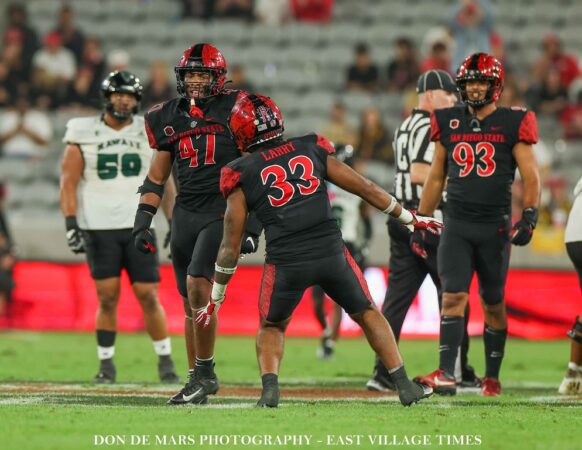
A football season is a journey. Each game is an opportunity to prove a team’s worth.
San Diego State failed early season tests against Oregon State and Cal, revealing that the hoped-for quick turnaround was not in the cards. Close games against Central Michigan and Hawai’i showed SDSU’s growth in making winning plays down the stretch.
Saturday will measure how close the Aztecs are to mastering the new philosophy head coach Sean Lewis has brought to The Mesa.
In the year’s second game, OSU dominated the Aztecs with a ball-control running game and opportunistic passing attack. They held the Red and Black’s offense to a season-low 49 plays and 179 total yards by possessing the ball for 41:07.
The Beavers’ approach is the tried and true way to stop up-tempo offenses. No matter how modern and potent a system might be, a team cannot do damage from the sideline. Following that contest, Lewis spoke about forcing the opposition out of the ground-and-pound strategy and making them play SDSU’s preferred style.
In the second game of Lewis’ tenure, the Aztecs did not have the skill to dictate much to Oregon State. Wyoming will attempt to duplicate OSU’s game plan. If the Cowboys successfully take the air out of the ball, it will show that Lewis’ coaching has yet to take hold.
UW has struggled this season. Their total defense ranks 104th in the country, giving up 407.2 yards per game. They are no. 132 (out of 133 teams) in total offense, averaging only 242 yards. They have converted 70 first downs – nine of those have come via penalty.
The Aztecs have not been much better, and the Cowboys can craft a similar but opposite narrative. What makes the game compelling is how much it will reveal about each team. Both have first-year head coaches. Whichever club controls the type of game played will reveal who is closer to reaching excellence in their respective systems.
Below are ten storylines to follow.

10. Intermediate passing game
Four FBS signal-callers have thrown 100 passes this season without an interception. Three of them are upperclassmen. The other is SDSU true freshman QB Danny O’Neil.
Handed the keys to Lewis’ offense earlier than expected, O’Neil has looked like a veteran when protecting the football. His careful approach, though, has limited the offense’s potency.
O’Neil has thrown short and deep passes with skill but few intermediate routes. With an offense unable to stay ahead of the chains because of an inconsistent running game, O’Neil has been forced to convert frequently from third and long.
Aside from effective screen passes, the young quarterback has looked lost in these situations. Unable to pick up first downs, SDSU has been dependent on big plays to generate offense. Saturday offers a perfect opportunity for growth.
Wyoming is last in the country at generating turnovers. Defensive back Wrook Brown’s interception against BYU is the Cowboys’ only takeaway this season. Their weakness in this area could benefit O’Neil’s learning curve.
All quarterbacks walk a fine line between aggressiveness and carelessness. O’Neil does not have the experience to know his limits. Postgame against Hawai’i, Lewis, and O’Neil spoke about how invaluable practicing against SDSU’s secondary has been in this process.
The Cowboys are a team against which O’Neil can push his boundaries. Even if he throws an interception on Saturday, it might be worth it in the grand scheme of his career.

9. QB Power Run
Due in part to former Wyoming great Josh Allen’s success with the Bills in the NFL, the Cowboys’ signature offensive play is the QB power run. Current signal caller Evan Svoboda executes it well. In short yardage, it remains one of UW’s staples.
The tactic has evolved since Allen’s day. It has RPO elements that prevent safeties from helping in the run. Wyoming has built numerous options off of it. They were effective two weeks ago in their 31-19 victory over Air Force.
From the shotgun, Svoboda took the snap. His first read was to hand off to the running back. If he kept it, the quarterback followed the back up the middle, giving Wyoming seven blockers at the point of attack. The Cowboys scored one touchdown on the give when Air Force’s linebackers keyed on Svoboda and two scores when Svoboda kept the ball. They also had a touchdown on a jet sweep from the formation.
In many ways, it is Wyoming’s version of the triple option but out of the spread. Handing off to the running back is like a fullback dive. They use motion to set up speed options and other wrinkles while calling Svoboda’s number to attack various gaps. Since its base is the spread, passing is effective from it because the run demands so much attention.
8. Road Warriors?
At 2-3, the Aztecs have yet to play great football this season. That SDSU travels halfway across the country as favorites encapsulates Wyoming’s year. Aside from the 31 in its win over Air Force, whose only win was over 1-4 FCS Independent Merrimack, the Cowboys have not scored more than 17 points in any contest.
While SDSU has yet to sustain excellence in any single game, it has been consistent in its play. Snapdragon Stadium or on the road, the quality of its execution has mostly stayed the same.
Penalties can signify an undisciplined team, though there are other causes. Consistency can point to discipline. It is worth watching how SDSU competes in a challenging environment.
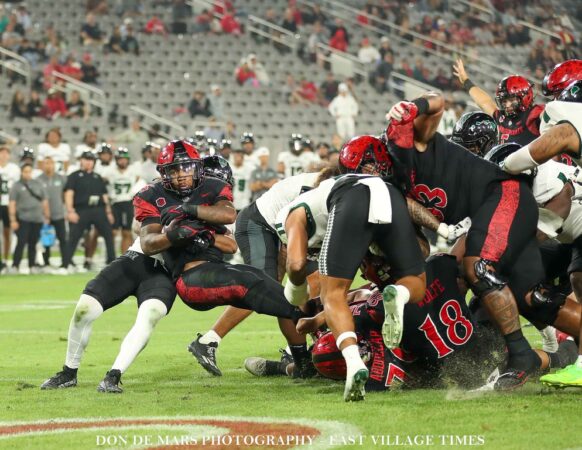
7. Marquez Cooper unbottled
Postgame against Oregon State, Lewis said he needed to improve as a playcaller by making sure Marquez Cooper touched the ball more. His idea has merit. SDSU is 2-1 when Cooper touches the ball 30 times, with the only loss being the field goal debacle game against Central Michigan.
Cooper has rushed for over 100 yards in the past two games, but his yards per carry has suffered. He has a 3.4 average over his last 64 attempts. Most of that came on long runs of 31 and 47 yards to set up touchdowns for the offense. The NCAA’s active career rushing leader is the Aztecs’ best player and deserves all the carries he can get. The storyline to follow is how Lewis schemes to improve Cooper’s opportunities.
Central Michigan and Hawaii are not stout up front but contained Cooper when the Aztecs did not win the numbers game. Aside from the read/option, there are other ways to create space for him. Lewis implemented them against Hawai’i.
Four passes were thrown to Cooper for 28 yards. If a defense is going to stay tight inside, giving Cooper the ball on the outside and allowing him to work one-on-one in space is a good strategy. Lewis also allowed his star back to begin north and south more after the Chippewas attacked the line of scrimmage when SDSU ran east and west.
The Aztecs also employed bubble screens and the quick passing game. Other possibilities include using a tight end as a lead blocker for Cooper, playing two tight ends to allow for more double teams on the line, and running draws. Lewis’ adjustments to free up Cooper will be something to watch on Saturday.
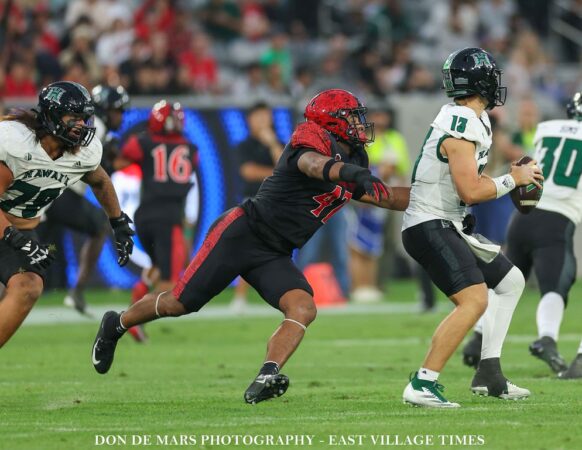
6. Competitive QB
SDSU’s defensive Achilles heel has been competitive signal callers, who have found ways to make off-script plays. In each contest against FBS opponents, the Aztecs have given up long touchdown drives. At one point in most of those, the opposing QBs extended the series by picking up key third downs with their feet.
Svoboda finds success through grit more than precision. He is a gamer who frustrates defenses by creating plays when they are not there. Missed opportunities to finish sacks have cost the Aztecs this season. Capitalizing on bringing Svoboda to the turf when they can will be key on Saturday.
Reserving a defender as a QB spy could prove effective, but there is no obvious fit for the role except in passing downs. Cody Moon might be the linebacker best suited for the job. Bringing Dalesean Staley down is an option, but that will prevent him from helping in the passing game. Turning Svoboda into a pocket passer might be worth whatever it takes to force him into that.
5. One, Two, Three, Out
Wyoming has been held to three and outs on 32% of its drives. SDSU’s offense can continue playing at its current level and still leave Laramie with a win if its defense can force multiple short drives on Saturday. UW will not dominate time of possession from the sideline.
Winning first down will be critical to achieving this end. Wyoming only averages 2.8 yards per rushing attempt, and Svoboda completes just 49.1% of his passes. Until UW proves it can execute with precision, a vanilla approach might be all that is needed.
The Cowboys’ offensive challenges are even more pronounced in their three FBS losses. Sixteen of UW’s 35 possessions in those contests resulted in a punt after three plays. Wyoming had only two three-and-outs against Idaho and Air Force.
The number of short drives UW has this weekend will indicate the quality of SDSU’s defense.
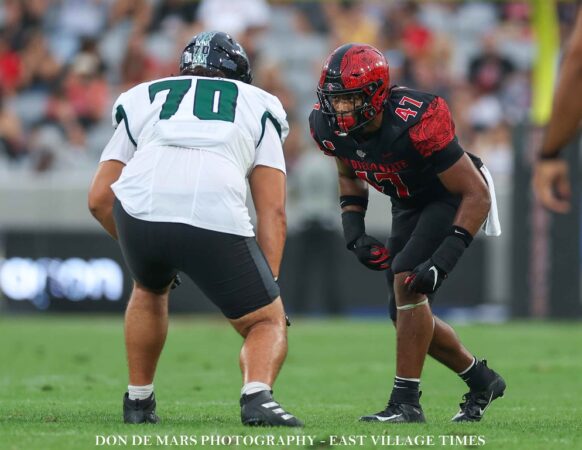
4. White’s Robin
The Cowboys have improved as the year has gone on at protecting Svoboda. They gave up seven sacks the first two games of the season, a pair the next two weeks, and none to Air Force. As the nation’s sack leader, Trey White looms large in this matchup, but which teammate steps up next to him is also intriguing.
Playmakers leave a wake behind them on the field. They are disruptive and create gaps and opportunities for athletes smart enough to understand the opportunities their elite teammates create. Opportunistic safeties, for example, follow around the hard hitters on the defense, knowing that big hits jar balls loose.
Marlem Louis excelled in the havoc White created last week, recording two sacks. Both occurred when Hawai’i’s QB tried to climb the pocket. Once, the signal caller was fleeing White’s pursuit. The other was when the QB attempted to flow to the area White vacated.
The chess match is afoot. Expect Wyoming and the rest of SDSU’s opposition to try to limit White. Hawai’i tried a technique to force the EDGE inside; the Aztecs countered that by stunting White into the middle of the defense.
The Cowboys mass protect frequently, only sending three into the pattern. White typically lines up on the side opposite the tight end. Doubling him requires a running back or guard to engage him in addition to the tackle. Blitzing linebackers could exploit this strategy.
More than just schematically, those around White should flow to him. If Louis is blocked, he should head in White’s direction, knowing that his teammate is likely around the ball. Owen Chambliss posted on social media this week that White is the best defensive player in the Mountain West. White’s teammates should watch his film to know how to compete around him.
SDSU’s star has proven to be Batman. He needs a sidekick.
3. Third Down Conversions
The Aztecs were a stellar 3-3 on fourth downs against Hawai’i. On the other hand, they were 0-3 on the third downs that preceded them. SDSU has converted just 35.1% of its third-down tries. They rank no. 103 in the country in that category. Wyoming is nine spots higher, with a 36.5 conversion percentage.
Defensively, the Cowboys are ranked 13th in the country, allowing conversions on only 29.7% of third-down attempts. The Aztecs’ defense matches its offense, ranking no. 103. They give up a first down 43% of the time.
Wyoming’s defense has given up the chunk plays that SDSU has needed to generate offense, so the impact of third down might be mitigated. However, in the coming weeks, the Aztecs will compete against potent attacks they will likely need to keep pace with. Sustaining drives against the Cowboys would be a confidence builder heading into those contests.
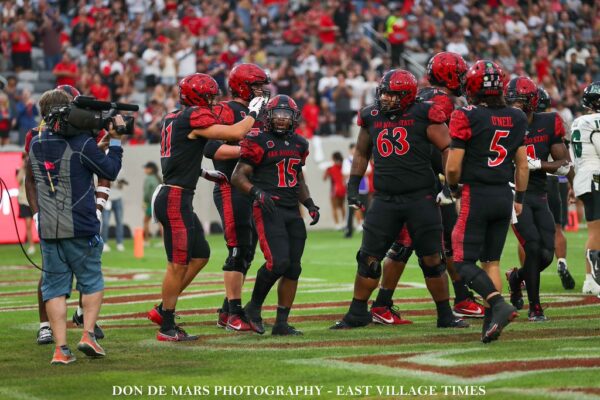
2. Scoring 30 points against an FBS opponent
The most surprising aspect of the 2024 season is how similar it is to last year. SDSU has been led by its defense. When it performs well, the Aztecs can compete. Poor offense has placed undue pressure on the team, leading to late-game collapses.
Lewis was brought to San Diego to change that script, but old habits apparently die hard. Saturday’s contest will be the halfway point of SDSU’s new head coach’s tenure. No longer a stranger on The Mesa, looking for signs of progress against Wyoming is a storyline to follow.
The Aztecs have yet to score 30 points against an FBS opponent this season. Even in the season opener against Texas A&M-Commerce, it mustered just 31, needing two defensive scores to reach 45. A potential trend of improvement could be developing. They scored 0, 10, 21, and 27 the last four weeks. Wyoming’s defense offers a terrific opportunity to continue the increasing totals.
The Cowboys’ defense is likely looking at their contest with the Aztecs as a chance to improve some of its meteoric numbers. SDSU scores only 20.6 points per game, no. 113 in the nation. Wyoming gives up 32.4 points on average, a 3.35-point improvement from two weeks ago after they gave up 19 to Air Force.
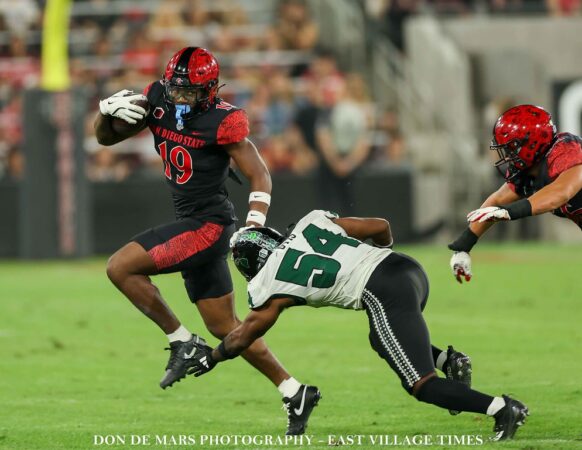
1. Mean Green, San Diego State
Sports is a copycat industry. North Texas provided the Aztecs with a potential game plan against Wyoming. Undoubtedly, Wyoming will use that game film to address its weaknesses. Three weeks ago, UTN dominated UW 44-17.
Air Force did not possess the athletes or system to match North Texas. SDSU might be able to approximate UNT’s approach. Could Lewis turn his squad into the Mean Green?
North Texas has moved away from the Veer and Shoot in favor of an Air Raid approach. A simplistic comparison of the systems is that they share theories about spacing and tempo but differ in how they reach their similar beliefs. The Veer and Shoot features the running game more than the Air Raid does.
What North Texas did well against Wyoming was something the Aztecs have failed to consistently accomplish this season. They stretched the Cowboys’ defense horizontally using jet sweeps, bubble screens, and four-wide sets.
With UW spread out, UNT gashed them vertically. The Cowboys’ defense was not athletic enough to wrap up the Eagles’ athletes in space. Twenty-three percent of UNT’s 75 plays went for ten or more yards, including five of at least 20 yards and one 40-yard gain.
Wyoming has had an extra week to correct its issues with North Texas’ attack. SDSU should test them to see if they have found solutions.
Tight end Michael Harrison could be featured this week. Lewis splits him out more than Jude Wolfe when he is SDSU’s tight end. Another UNT tactic the Aztecs could copy is using Wolfe or Gabe Garretson as an H-Back instead of at the line. The Mean Green neutralized Wyoming’s blitzes by having two extra blockers in the backfield. UNT’s running backs also benefited from having a lead blocker.
The Cowboys rank no. 104 in total defense, giving up 407.2 yards of total offense. Number 104 (185.2) in rushing yards allowed and no. 81 (222) passing yards allowed is how they split between the two facets of the game.
Its contest against Air Force skewed Wyoming’s defensive numbers, but not as expected. Air Force only averages 173 yards on the ground. They mustered 205 against the Cowboys, close to UW’s yearly norm. The Falcons threw for 105 yards, reducing the Cowboys’ passing yards average by nearly 30 yards per game.
Is a 400-yard game against Wyoming in the Aztecs’ future?
My earliest sport’s memory involve tailgating at the Murph, running down the circular exit ramps, and seeing the Padres, Chargers and Aztecs play. As a second generation Aztec, I am passionate about all things SDSU. Other interests include raising my four children, being a great husband and teaching high school.